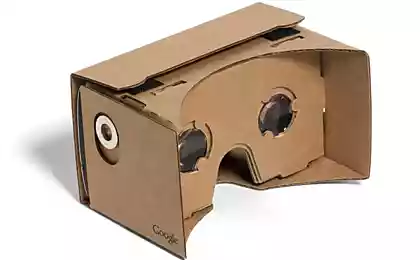703
The most comprehensive analysis of the Google Glass
For the first time since the start of the testing device (April 2012) Google glasses were completely dismantled. Hackers are likely stopped the threat disable glasses violation of the terms of use and the high price of the device - $ 1,500, but in this case helped Nathan Seidl, head of Sparkfun Electronics, purchase and removing the most senior Simpson and Scott Thorborg.
Getting points - not an easy task, because at the moment they are available not for everyone, but only for developers of applications for the new platform. Extradition is just three points on the entire territory of the United States: in Mountain View (CA), Los Angeles and New York; studios around Google Glass in these cities can be seen constantly wandering aimlessly people getting used to the "Glass".
Lucky appointed time, and upon arrival, he is met by an employee "Google" with a bouquet of mimosas. Guglovets helps select the color device (charcoal dark, tangerine, slate, white or sky blue), and within 45 minutes, explains how to use glasses, including shows how to connect the other phone, and link your «Google».
Points are issued in a beautiful and convenient box of fully recycled paper. The kit includes a USB cable and a charger, a small cloth bag to the cords, darkened and transparent shields.
Will be 23 photos and descriptions

2.

3. As Dustin Curtis, Star and Scott paid attention to build quality. By the way, along with the points they gained access to the Mirror API, a platform on which applications are created for "Glass».

4. The researchers immediately went to the lab and started dismantling. They noted that at a certain dexterity and have experience points can disassemble and assemble back, causing them to a minimum, purely cosmetic damage. His copy of the device hackers successfully gathered back. It has been suggested that the glasses may be uniformly filled with epoxy or some varnish, which does not allow without a strong solvent to study their internal structure. This, of course, was not so.
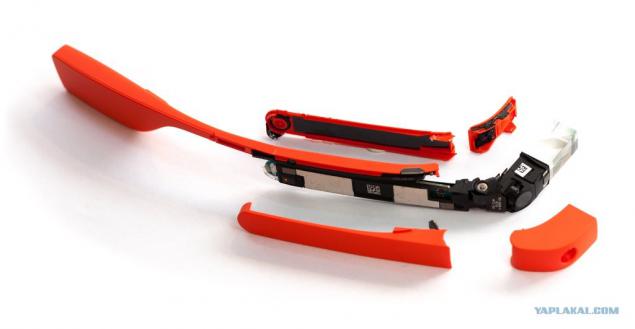
5. Not knowing where to start and hackers removed the attachment to titanium bow, loosening the screw with a radial slot type Torx.

6. They immediately began to see the usually hidden serial number.

7. As planned, the "Glass" is not difficult to fix on conventional glasses, but official support of this yet. To use the device in such a case would be inconvenient because the proximity sensor head behaves improperly, focusing on the glasses lens.

8. The part of the body was discovered near the screen
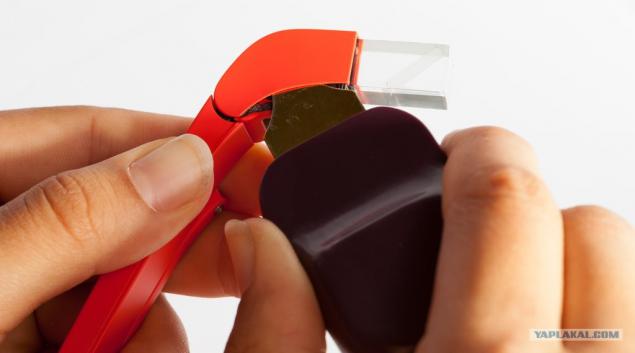
9. The photograph shows the sensor head position and, presumably, a light sensor.

10. On the side surface of the glasses is the touchpad. As it turned out, this model The Synaptics running controller Synaptics T1320A.

11. The picture shows the motherboard unit, already stripped of a large amount of thermal paste. The core of the system have long known: that TI OMAP4430 (Cortex-A9), gigabytes of RAM Elpida production and 16 GB of flash memory.

12.

13. The board meets a strange marking Google [X] production.

14.

15. Tearing plastic, hackers discovered that the battery unit is located behind the ear to maintain balance. In case it indicates that it has a capacity of 2.1 W · hr (about 570 mAh). The battery can not be changed because it is soldered to the flexible printed circuit board.

16. Over the ear in front of the battery is the speaker that transmits sound directly into the bone, combined with tactile button.

17. The system board, the display, the camera, and sensors connecting another flexible printed circuit board, enveloping these components.

18. It is fastened inertial sensors InvenSense MPU-9150

19. The greatest interest in the glasses is of course the screen.
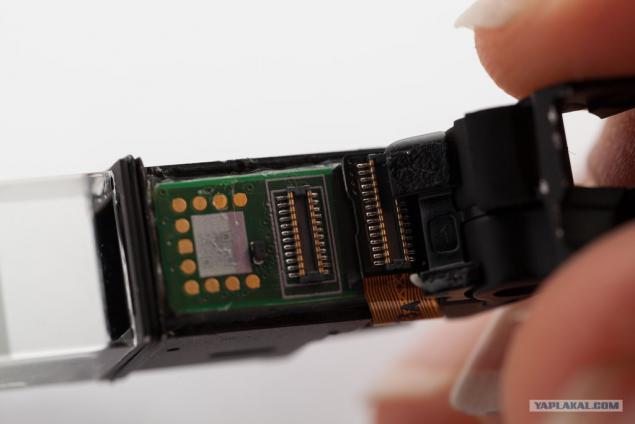
20. With this miniature display resolution of 640 × 480 pixels by a small number of optical elements of the image projected on the screen. As a result, in the upper right corner of a feeling a little floating images in a few meters away from the face. In the first photo the monitor lying on the dime, its diameter is 17, 91 mm (a little less than 1 ruble coin).

21.

22.

23. The "Glass" typical smartphone camera. The signal from it goes to the CPU direct access to the screen it has.
Posted in [mergetime] 1371159031 [/ mergetime]
In general, hackers described the device as "surprisingly easy". It is hoped that the recommended price of the headset will be well below the price of the prototype.
Rested here
All you can kick!
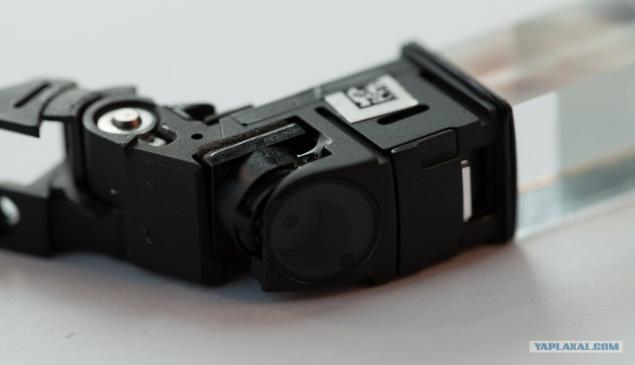
Source:
Getting points - not an easy task, because at the moment they are available not for everyone, but only for developers of applications for the new platform. Extradition is just three points on the entire territory of the United States: in Mountain View (CA), Los Angeles and New York; studios around Google Glass in these cities can be seen constantly wandering aimlessly people getting used to the "Glass".
Lucky appointed time, and upon arrival, he is met by an employee "Google" with a bouquet of mimosas. Guglovets helps select the color device (charcoal dark, tangerine, slate, white or sky blue), and within 45 minutes, explains how to use glasses, including shows how to connect the other phone, and link your «Google».
Points are issued in a beautiful and convenient box of fully recycled paper. The kit includes a USB cable and a charger, a small cloth bag to the cords, darkened and transparent shields.
Will be 23 photos and descriptions

2.

3. As Dustin Curtis, Star and Scott paid attention to build quality. By the way, along with the points they gained access to the Mirror API, a platform on which applications are created for "Glass».

4. The researchers immediately went to the lab and started dismantling. They noted that at a certain dexterity and have experience points can disassemble and assemble back, causing them to a minimum, purely cosmetic damage. His copy of the device hackers successfully gathered back. It has been suggested that the glasses may be uniformly filled with epoxy or some varnish, which does not allow without a strong solvent to study their internal structure. This, of course, was not so.

5. Not knowing where to start and hackers removed the attachment to titanium bow, loosening the screw with a radial slot type Torx.

6. They immediately began to see the usually hidden serial number.

7. As planned, the "Glass" is not difficult to fix on conventional glasses, but official support of this yet. To use the device in such a case would be inconvenient because the proximity sensor head behaves improperly, focusing on the glasses lens.

8. The part of the body was discovered near the screen

9. The photograph shows the sensor head position and, presumably, a light sensor.

10. On the side surface of the glasses is the touchpad. As it turned out, this model The Synaptics running controller Synaptics T1320A.

11. The picture shows the motherboard unit, already stripped of a large amount of thermal paste. The core of the system have long known: that TI OMAP4430 (Cortex-A9), gigabytes of RAM Elpida production and 16 GB of flash memory.

12.

13. The board meets a strange marking Google [X] production.

14.

15. Tearing plastic, hackers discovered that the battery unit is located behind the ear to maintain balance. In case it indicates that it has a capacity of 2.1 W · hr (about 570 mAh). The battery can not be changed because it is soldered to the flexible printed circuit board.

16. Over the ear in front of the battery is the speaker that transmits sound directly into the bone, combined with tactile button.

17. The system board, the display, the camera, and sensors connecting another flexible printed circuit board, enveloping these components.

18. It is fastened inertial sensors InvenSense MPU-9150

19. The greatest interest in the glasses is of course the screen.

20. With this miniature display resolution of 640 × 480 pixels by a small number of optical elements of the image projected on the screen. As a result, in the upper right corner of a feeling a little floating images in a few meters away from the face. In the first photo the monitor lying on the dime, its diameter is 17, 91 mm (a little less than 1 ruble coin).

21.

22.

23. The "Glass" typical smartphone camera. The signal from it goes to the CPU direct access to the screen it has.
Posted in [mergetime] 1371159031 [/ mergetime]
In general, hackers described the device as "surprisingly easy". It is hoped that the recommended price of the headset will be well below the price of the prototype.
Rested here
All you can kick!

Source:




